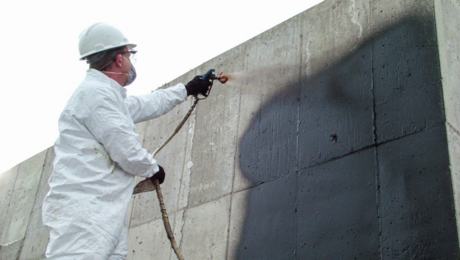Basement Waterproofing Technologies
Basement leakage is the most common problem found in houses, and over 90% of all basements will leak and suffer damage at one time or another. Some evidence of moisture penetration can be found in almost every house. A house with water problems does not necessarily mean it was poorly constructed. Water can appear in even the best-built home.
Moisture problems can be intermittent. In some houses, water penetration will occur after virtually every rainfall. In other houses, it will occur only after periods of prolonged rain. In most cases, however, the resultant damage does not indicate frequency.
Not all basement leakage problems are solvable, but the majority of leakage problems can be solved by directing surface water away from the building around the foundation or/and using a downspout extension to force rainwater to flow away from the house.
Warning signs of water leakage:
- Mold and mildew: Fungus that grows in damp and dark areas, and causes discoloration, or musty odors.
- Musty odors: This could result from the decay process of mold and dry rot.
- Peeling paint
- Damp spots on walls: Water has absorbed through your walls.
- White substance on basement walls: This is a chemical breakdown of the bonding agent that holds your walls together. The white substance is a sign of possible structural deterioration.
- Cracked walls: Should be inspected to determine the exact cause.
- Rust on appliances, furniture, or furnaces.
- Dry rot: Black fungus grows mostly on walls or wooden surfaces, causing wood to decay.
Why is waterproofing important?
A wet basement can dramatically reduce the value of your home. Studies show that most people won't even consider buying a home with water leakage. Selling a home with water leaks can easily result in as much as a 25% reduction in the sale price.
Even if you rarely have problems with dampness or flooding, it's best to solve the problem completely before doing any remodeling work. Permanent solutions can take time to implement. A good place to start is to talk to an independent home inspector who specializes in waterproofing problems.
Damp proofing or waterproofing on walls?
There is a big difference between damp proofing and waterproofing. By definition, dampproofing can retard moisture but, unlike waterproofing, it does not stop hydrostatic water pressure.
To damp-proof, you apply a coat of tar-based material to the outside walls. Tar damp proofing is inexpensive and meets the lowest minimum standard.
Damp proofing may be acceptable if there is a sandy soil and great drainage. But often, there is a high water table or poor soil. Clay holds rainwater, which builds up hydrostatic pressure against the foundation. Moreover, water cannot drain through the undisturbed soil under the footings and groundwater level rises.
Complete waterproofing is ideal
Good waterproofing is a wise investment. It is not just a coating but a whole system that includes:
1- Redirect water away from the foundation
The various exterior waterproofing barriers have varying levels of effectiveness in protecting the outside wall areas. But wall anti-leaking barriers do not affect water penetration due to water accumulation at the footer or floor level. The ideal solution to this problem lies in directing the accumulation of water away from the foundation or into drainage or pumping systems.
2- Install an interior drainage system
To control leakage in the basement, you may want to install a drainage system on the inner side of the foundation. The floor is broken up along the perimeter of the basement wall and drain tile is placed in a trench that carries the water to a discharge point, or sump pump, which takes the water away from the house.
3- Apply waterproofing compounds to the walls
With mild or occasional capillary seepage, capillary waterproofing materials can be applied to either exterior or interior wall and floor surfaces. If properly applied, they will penetrate several inches into concrete and close off minor cracks by forming crystals in the presence of water. You should carefully read the product label to determine if the product waterproofing limitations is sufficient to fix the problem. Waterproofing paint is most effective if applied directly over cement and not to existing painted walls.


